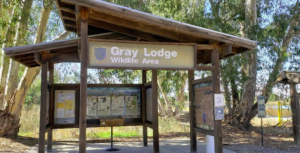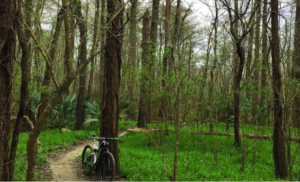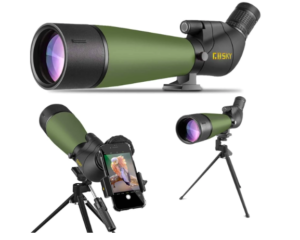Best Bike Trails in New Orleans
Welcome to New Orleans, Louisiana, where the charm of Southern hospitality meets the excitement of outdoor adventure. If you enjoy riding or just want to explore the city on two wheels, you’re in for a treat. New Orleans has a variety of bike routes that run through its historic neighborhoods, gorgeous parks, and along the breathtaking coastline. Whether you’re a casual rider or an enthusiastic biker, there’s a route for you. Let’s explore the universe of bike paths in New Orleans and find the best routes to ride your way through this interesting metropolis.
Best New Orleans Bike Trails.
1- Lafitte Greenway Trail New Orleans:

The Lafitte Greenway is a well-known and well-used bicycle and walking route in New Orleans, Louisiana. This 2.6-mile multi-use walkway connects various diverse districts along the way, stretching from Basin Street in the historic Tremé area to North Alexander Street.
Highlights and features:
Paved Path:
The Greenway has a paved surface that is excellent for both bikers and walkers. The well-kept route guarantees that hikers have a pleasant and pleasurable experience.
Beautiful Green Spaces:
You’ll pass through magnificent green places, including parks and recreational areas, as you bike or stroll along the Lafitte Greenway. These give possibilities for respite, picnics, and relaxation in the heart of the city.
Installations of Public Art:
The Greenway has a number of public art projects that lend a creative and cultural element to the path. These artworks add to the overall visual appeal and provide distinct areas of interest.
Connections in the Neighborhood:
The Lafitte Greenway’s significance in linking various distinct communities in New Orleans is one of its primary benefits. It runs through or near communities including Tremé, Mid-City, and Bayou St. John, making access easier and encouraging community involvement.
Safe and well-lit:
The trail was built with safety in mind. It is well-lit, which improves visibility at night, and it has marked crosswalks and signs to assure user safety at crossings.
Bicycle Amenities:
Along the Lafitte Greenway, you’ll find various amenities catering to cyclists. These include bike racks, repair stations, and bike rental facilities, making it convenient for riders to enjoy the trail. Fitness and Recreation Opportunities: The Lafitte Greenway serves as a hub for fitness enthusiasts and recreational activities. It provides a dedicated space for jogging, biking, rollerblading, and walking, encouraging an active and healthy lifestyle.
Overall, the Lafitte Greenway in New Orleans provides a picturesque and well-connected path for bikes and walkers, supporting a healthy lifestyle and community participation while delivering a safe and pleasurable experience. It mixes recreational activities, cultural aspects, and transit access, making it a treasured part of the city’s urban fabric.
2- Mississippi River Trail (Crescent Park)

The Crescent Park Mississippi River Trail is a scenic and popular bike and walking trail in New Orleans, Louisiana. This route offers spectacular river views, recreational places, and a tranquil setting for outdoor enthusiasts to enjoy. It is located along the banks of the mighty Mississippi River.
Highlights and features:
Views of the River:
Crescent Park’s Mississippi River Trail offers beautiful views of the Mississippi River. Cyclists and pedestrians may enjoy the flowing water’s magnificence, watch riverboats pass by, and take in the natural splendor of the riverbank.
Paved Road:
The route has a well-kept paved surface that provides a smooth and enjoyable ride for bicycles, joggers, and pedestrians. The level landscape makes it suitable for persons of all ages.
Crescent Park:
The trail is situated within Crescent Park, a vibrant public park that spans 1.4 miles along the riverfront. The park features lush green spaces, open lawns, and scenic overlooks, providing opportunities for relaxation, picnicking, and enjoying the outdoors.
Recreational Areas:
There are a variety of recreational opportunities along the Mississippi River Trail. Fitness stations, playgrounds, sports courts, and facilities for yoga or outdoor exercise may be included. These features make the path an adaptable location for both physical exercise and recreation.
Neighborhood Connection:
The path connects numerous New Orleans areas, including the French Quarter and the Bywater. It provides residents and visitors with a convenient way to commute between these places and explore the neighboring villages.
Design for Pedestrians:
Crescent Park’s Mississippi River Trail is developed with pedestrian safety in mind. It has designated pedestrian sections that are distinct from the bike lane, ensuring that walkers have a pleasant experience.
Installations of Outdoor Art:
The route and Crescent Park are home to a number of outdoor art projects such as sculptures, murals, and interactive pieces. These creative pieces provide aesthetic beauty and cultural value to the route, providing visitors with a one-of-a-kind and engaging experience.
Promenade along the Waterfront:
The route links to a lovely waterfront promenade that runs the length of the river. This promenade is ideal for a leisurely stroll or for sitting and soaking in the sights while enjoying the pleasant breezes from the river.
Environment That Is Dog-Friendly:
Leashed dogs are accepted on the Mississippi River walk, allowing pet owners to enjoy the walk with their canine companions. It is critical to observe local pet restrictions, keep dogs under control, and clean up after them.
Overall, the Mississippi River Trail within Crescent Park offers a scenic and enjoyable experience for cyclists, joggers, walkers, and nature lovers. With its stunning river views, recreational spaces, and community events, it provides a tranquil escape from the bustling city, while celebrating the natural and cultural heritage of New Orleans.
3-New Orleans Lakefront Trail;

The New Orleans Lakefront track is a popular and attractive bike and walking track in New Orleans, Louisiana that runs along the shoreline of Lake Pontchartrain. This 3.5-mile paved route provides residents and visitors with spectacular views of the lake, recreational activities, and a refreshing outdoor experience.
Highlights and features:
Views of the lake:
The Lakefront Trail offers breathtaking views of Lake Pontchartrain. Cyclists and pedestrians may take in the quiet serenity of the lake, watch sailboats glide by, and gaze out at the vast water horizon.
Paved Road:
The route is paved, which makes for a smooth and comfortable surface for biking, running, and walking. The well-kept route guarantees that users of all ages and abilities have a pleasant experience.
Beautiful Green Spaces:
Pockets of green space, including parks and open areas, may be found along the Lakefront Trail. These areas are ideal for relaxing, picnics, or simply taking a pause to appreciate the natural surroundings.
Beach accessibility:
The Lakefront Trail connects to a number of public beaches along Lake Pontchartrain. Visitors may swim in the lake, relax on the sandy shores, or have a picnic on the beach with family and friends.
Amenities for recreation:
Users may enjoy a variety of recreational attractions on the path. Fitness stations, playgrounds, basketball courts, and specialized locations for outdoor activities such as yoga or group workouts may be included.
Airy Atmosphere:
The Lakefront Trail benefits from the cool air from Lake Pontchartrain. Even in the summer, the cool air and waterfront atmosphere make it a pleasant spot to workout.
Sunset Location:
The Lakefront Trail is an excellent place for viewing magnificent sunsets across the lake. Trail users enjoy watching the brilliant hues of the sky as the sun sets below the horizon.
Dining and entertainment options:
There are a range of food alternatives near the Lakefront Trail, ranging from casual cafés to seaside restaurants. There are other entertainment locations where you may listen to live music or watch other cultural acts.
The Lakefront neighborhood is historically significant in New Orleans, primarily as a location for early colonization and trade. You may appreciate the trail’s relationship to the city’s past and the region’s cultural heritage as you explore it.
Community Activities:
The Lakefront Trail holds community activities such as outdoor concerts, art fairs, and festivals on occasion. These events give locals and tourists with opportunities.
4- Audubon Park Trail

The Audubon Park route is a scenic and one of the best bike trails in New Orleans and popular bicycle and walking route located within New Orleans’ Audubon Park. This trail, located in the center of Uptown, provides a tranquil and picturesque route for outdoor enthusiasts to enjoy.
Highlights and features:
Beautiful Park Location:
The Audubon Park Trail winds across the park’s rich flora and lovely scenery. The park is recognized for its well-kept lawns, massive oak trees, and vivid gardens, which provide trail users with a calm and pleasant setting.
Paved Road:
The paved surface of the path makes it appropriate for both bikes and walkers. The smooth walkway guarantees that users of all ages and fitness levels have a pleasant and pleasurable experience.
Leisurely Biking:
The Audubon Park Trail is ideal for leisurely biking. With its gentle slopes and well-paved surface, it offers a relaxed and pleasant ride for cyclists who prefer a slower pace and enjoy the natural surroundings.
Scenic Views:
As you explore the trail, you’ll be treated to scenic views of Audubon Park’s various elements, including its iconic oak trees, picturesque lagoons, and well-manicured gardens. These captivating views provide a sense of tranquility and natural beauty.
Wildlife Spotting:
Audubon Park is home to a diverse array of wildlife, including birds, turtles, and squirrels. The trail offers opportunities for wildlife spotting, allowing nature enthusiasts to observe and appreciate the park’s animal inhabitants.
Family-Friendly Setting:
This trail is ideal for families with children. Because of its mild slopes, well-paved surface, and closeness to playgrounds, it is a good alternative for parents to enjoy outdoor activities with their children, whether on foot or by bicycle.
Dog-Friendly Area:
The route is pet-friendly because Audubon Park accepts leashed dogs. Dog owners can take their pets for a stroll or run as long as they follow park rules and clean up after their pets.
Access to Additional Park Amenities:
Audubon Park, in addition to the route, has a variety of attractions for visitors to enjoy. These include the Audubon Zoo, the Audubon Aquarium of the Americas, and the Audubon Butterfly Garden and Insectarium, all of which provide additional family adventures and educational possibilities.
Significance in Cultural and Historical Terms:
Audubon Park in New Orleans has a rich history and cultural value. The park’s name honors the famed naturalist and painter John James Audubon. Visitors may comprehend the park’s relationship to Audubon’s legacy and the conservation efforts it represents by exploring the route.
5- The Bonnet Carre Spillway

The Bonnet Carre Spillway is an important flood control structure located about 30 miles upriver from New Orleans in Norco, Louisiana. During seasons of high water levels, it acts as a release valve for surplus water from the Mississippi River, assisting in the protection of downstream regions from potential floods. The Bonnet Carre Spillway is explained in full below:
Function & Purpose:
The Bonnet Carre Spillway’s major function is flood management. When the Mississippi River reaches a specific level, the spillway opens to redirect a portion of the river’s flow into Lake Pontchartrain and, eventually, the Gulf of Mexico. This aids in the prevention of floods in downstream locations, such as New Orleans and nearby villages.
Design and construction:
The Bonnet Carre Spillway is made up of 350 bays separated by 20-foot-wide gates. These gates are opened to allow river water to enter the spillway’s diversion channel. The spillway encompasses around 6,700 acres.
Operation:
The Bonnet Carre Spillway is operated and maintained by the United States Army Corps of Engineers. When the Mississippi River reaches a specific water level at the Carrollton Gauge in New Orleans, the Corps closely monitors the river’s flow and decides whether to open the spillway to relieve downstream pressure.
Environmental Implications:
The Bonnet Carre Spillway has both beneficial and bad environmental consequences. On the plus side, it relieves pressure on the levee system, lowering the likelihood of catastrophic flooding in inhabited areas. Furthermore, the diverted water replenishes the brackish waters of Lake Pontchartrain, encouraging fish and animal production.
Negative Consequences:
The freshwater intrusion from the spillway can have a severe impact on the lake’s environment. Increased fertilizer loading can result in algal blooms, oxygen deprivation, and fish mortality. It can also change the salt levels in the lake, impacting the marine life balance.
Recreational Possibilities:
When the spillway is open, it provides unique recreational options. Anglers take advantage of enhanced freshwater flow, which attracts a variety of fish species. Furthermore, the wide bays of the spillway provide a lovely location for boating, birding, and wildlife photography.
Habitat for Wildlife:
A variety of animals, including migrating birds, fish, alligators, and turtles, use the spillway as a temporary refuge. Numerous species are drawn to the unique combination of aquatic and terrestrial ecosystems, which provides a significant refuge during high-water occurrences.
Spillway Management:
The Bonnet Carre Spillway’s opening is a highly planned and coordinated process. Before deciding to activate the spillway, the Corps of Engineers examines a number of criteria, including river stage, predicted rainfall, and downstream circumstances.
6-The Lafreniere Park Trail

The Lafreniere Park route is a popular recreational route located in Metairie, Louisiana, just west of New Orleans, within Lafreniere Park. This 2.8-mile route provides a lovely and serene setting for walkers, runners, and cyclists to enjoy outdoor sports. Making this one of the best Bike Trails New in Orleans. The Lafreniere Park Trail is explained in full here:
Park Scene:
The route is part of Lafreniere Park, a 155-acre urban park recognized for its natural beauty and well-kept landscapes. The park’s rich green grounds, stunning lakes, and diverse trees and flowers create a calm and appealing environment for visitors.
Paved Path:
The Lafreniere Park Trail is paved and smooth, making it a comfortable and accessible route for walkers, joggers, and cyclists. The well-kept walkway guarantees that visitors of all ages and fitness levels have a pleasant experience.
Views of Nature:
You’ll get stunning vistas of Lafreniere Park’s different attractions as you walk the route. Beautiful lake views, lovely bridges, and the park’s abundant flora and animals are all part of it. These magnificent sights improve the whole route experience.
Stations for Exercise:
The route includes fitness stations with workout equipment that are carefully positioned. These stations enable trail users to add strength training and stretching activities into their outdoor workout program, so boosting the route’s fitness options.
Playground and Recreational Facilities:
Lafreniere Park offers a range of recreational amenities, including playgrounds, sports fields, and tennis courts. The trail provides convenient access to these facilities, making it an ideal destination for families and individuals seeking active and engaging outdoor experiences.
Wildlife and Bird Watching:
Lafreniere Park is home to a variety of wildlife and serves as a habitat for numerous bird species. As you explore the trail, you may have the opportunity to spot ducks, turtles, squirrels, and a wide array of birds. Birdwatchers can bring their binoculars to observe the park’s avian residents.
Picnic spots:
There are designated picnic sites with tables and seats along the Lafreniere Park Trail. These areas are ideal for relaxing, having a picnic lunch, or simply enjoying the park’s peaceful atmosphere.
Dog-Friendly Setting:
Leashed dogs are permitted on the route, allowing pet owners to enjoy it with their four-legged pals. Dog owners must clean up after their pets and follow park laws on pet control and waste disposal.
Festivals & Seasonal Events:
Throughout the year, Lafreniere Park holds a number of seasonal events and festivals. Art displays, holiday festivities, concerts, and culinary festivals are examples of such events. The trail gives a handy vantage point from which to view these activities and engage in the park’s dynamic community vibe.
7-Fontainebleau State Park

Fontainebleau State Park is a lovely and diversified outdoor recreational area near Mandeville, Louisiana, located on the north coast of Lake Pontchartrain. Fontainebleau State Park, with its stunning natural surroundings, historic significance, and different amenities, provides visitors with a diverse choice of activities and experiences. Here’s a more in-depth look of Fontainebleau State Park:
Natural Environment:
Fontainebleau State Park encompasses over 2,800 acres and offers outdoor enthusiasts a clean and tranquil setting. The park contains a variety of ecosystems, including piney forests, marshes, and a sandy beach, resulting in a complex ecology and numerous fauna.
Pontchartrain Lake:
The park is located on the banks of Lake Pontchartrain, one of the United States’ biggest inland bodies of water. Visitors may enjoy breathtaking views of the lake as well as water sports.
Historical Importance:
Fontainebleau State Park was formerly a sugar plantation and then a luxurious vacation hotel. The remains of the ancient sugar mill and the renovated Fontainebleau Lodge (now the park’s visitor center) provide tourists a look into the area’s history as well as educational possibilities.
Nature and hiking trails:
Several kilometers of hiking and nature paths weave across the park’s various landscapes. These pathways allow visitors to explore the park’s natural splendor, watch animals, and enjoy the peace and quiet of nature. The routes vary in complexity, so hikers of all ability levels may enjoy them. Making this one of the best Bike Trails New in Orleans
Camping:
Fontainebleau State Park offers a camping experience surrounded by nature’s grandeur. It has both developed and rustic campsites, giving guests the option of RV camping with full hookups or tent camping in a more quiet location. Restrooms, showers, and a playground are available at the campground.
Lodging and Cabins:
The park has a selection of cottages that can accommodate families and groups for those looking for a more comfortable vacation. These cottages offer contemporary conveniences like kitchenettes, toilets, and air conditioning while still allowing guests to enjoy the park’s natural settings.
Picnic spots:
Fontainebleau State Park has a number of dedicated picnic spots with tables, grills, and shade structures. These locations serve as a magnificent backdrop for picnics, family reunions, and social trips, allowing people to enjoy alfresco meals in a gorgeous environment.
Viewing Wildlife:
The park is home to a wide range of species, including birds, deer, rabbits, and a variety of reptiles and amphibians. Birdwatchers may see a variety of species, making the park a popular location for birders.
Boating and fishing:
Lake Pontchartrain has good fishing chances, and fishermen may reach the lake via Fontainebleau State Park. Visitors can fish from the shore, from piers, or from the park’s boat launch. Speckled trout, redfish, and bass are among the most common fish species in the lake.
This is one of the best New orleans bike trails.
FAQs.
Are there bike trails in New Orleans?
Yes, there is a network of bike trails and bike-friendly infrastructure throughout New Orleans, including dedicated bike lanes and routes.
Where can I find bike trails in New Orleans?
Bike paths may be found throughout the city, including parks, levees, and dedicated bike lanes on city streets. The Lafitte Greenway, Mississippi River Trail, and City Park paths are also popular.
Are the bike paths appropriate for riders of all ability levels?
Yes, New Orleans has bike routes for bikers of all ability levels, from beginners to advanced riders. There are flat, simple paths as well as more difficult treks.
Can I rent bikes in New Orleans?
Yes, there are various bike rental businesses and bike-sharing programmes in New Orleans where you may borrow a bike for a few hours or the entire day.
Are the bike trails in New Orleans safe?
Many of New Orleans’ bike routes are safe for bikers, but it’s important to observe basic safety principles like wearing a helmet, following traffic regulations, and being aware of your surroundings.
Related Articles









